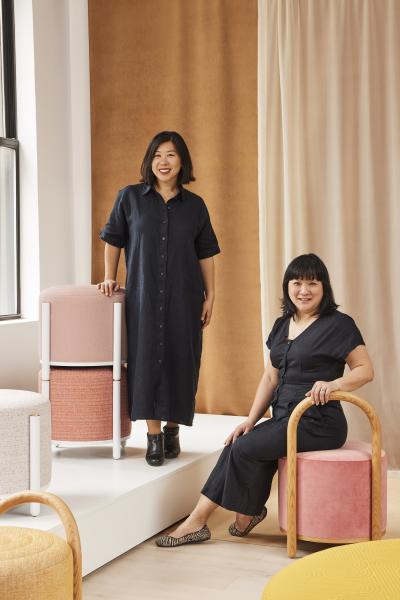In late spring, Asian-Pacific Islander- and women-owned design company Alda Ly Architecture and textile and furniture company HBF launched their first furniture collaboration. The new Bao seating line is named for the Chinese word “bao”—which can mean bun, bag, precious or baby—and was designed to meet a range of needs.
The collection is available in six base archetypes—small, medium, large half-round, stacking, low loop handle and high loop handle—and two seat heights (lounge and work). The pieces can be customized with different upholstery options and finishes.
Alda Ly, founder and principal of Alda Ly Architecture, recalled that HBF first approached her team with a brief for a pouf design as a collaboration. “They provided the prompt of coming up with a new kind of poof piece,” she said. “From there, they wanted to hear from us about our expertise in designing projects and specifying [elements], and that's where we really developed the more detailed design of this.”
“We were really allowed free rein to consider what approach we wanted to take to the design,” said Tania Chau, director of interior design at Alda Ly Architecture, adding that HBF had a “checklist” of functions they wanted the pouf to meet. Working together, the team looked at the marketplace to develop something that would work across a range of different verticals, but also be something to fill a niche in the marketplace—“Something that I, as a specifier, would want but haven't been able to find.”
Meeting Needs

and Tania Chau, director of interior design at Alda Ly Architecture. (Pippa Drummond)
Creating a line that would fit well in a range of spaces and meet a range of needs required being “thoughtful and clever” in terms of how the line’s functionality would work across a range of units, Ly said.
For example, the line needed to be mobile. Chau noted that during gatherings or events, people often want to move ancillary furniture around so that they can sit alone or in groups as needed.
“So how can we take the kind of behavior that already exists and make it easier for people to do?”
The team added a loop handle to the base design that the end user can grab to move the pouf wherever it is needed. The loop also doubles as a backrest.
“I think that [was] the design element that went through the most iterations,” Chau recalled. “We started off with a very simple, straight loop that bisected the piece, and in the process of development, we realized that that was not going to be very comfortable because it cut off part of the seating area and also hit the back at an odd angle.”
The ALA designers sketched out ideas for HBF on how that backrest could be more comfortable for people of different heights, creating prototypes for testing the different options and finding the right kind of loop.
The team also felt that the ability to easily stack poufs was missing from the marketplace. “When you're done with that all-hands meeting where 40 extra people descended into your office, where could that extra seating go?” Chau recalled thinking. Some of the units—designed to evoke Cantonese siu mai dumplings—have vertical supports in the legs that can securely hold another Bao piece on top, maximizing storage space when the units are not being used. “We always imagined that it would be a simple ‘pick it up and stack it on top,’” Chau said of the initial plan. Instead, HBF’s engineering team cut away some of the foam from the supports and used a pressure-fit mechanism to hold the stacked units in place. “When you pop it on, it feels secure because the pressure from the foam in the seat essentially locks the legs in place,” she said.
Perhaps most importantly for both mobility and stackability, Ly noted that the units are easy to lift and move. “It's quite intuitive in terms of where you can pick it up and grab it, or you can pick it up from the base of the pouf to lift it up.”
Some pieces look like half-circles (or the traditional gua bao pork belly bun) and can serve as small sofas when up against a wall or as ottomans when freestanding. The units have an interlocking mechanism to become a full circle when needed. “We wanted … ways that we could do double duty in the design,” Ly said.
What’s in a Name?
While each of the pieces evokes a different type of Asian dumpling, the name Bao actually came fairly late in the design process. HBF advised the ALA team to keep the name “simple and easy to remember,” Chau said—and also to use words near the top of the alphabet. The partners went through “many lists of possible names” and settled on Bao as it both met HBF’s requirements and felt personal to the ALA team.
“It's a Chinese word and we're both of Chinese descent,” Chau said. Similarly, the multiple definitions of the word suited the first-time collaborators. “It's almost like having a baby when you do your first design collection. Bao can mean ‘baby.’ And then we love also that it references the idea of a bag [or] a purse for the mobility aspect that we developed, so it ended up working out so perfectly.” For her part, Ly said the name embodies the “playfulness” of the piece.
